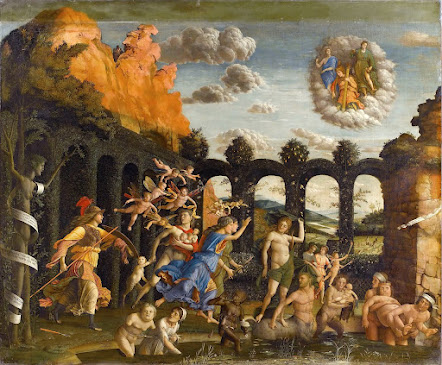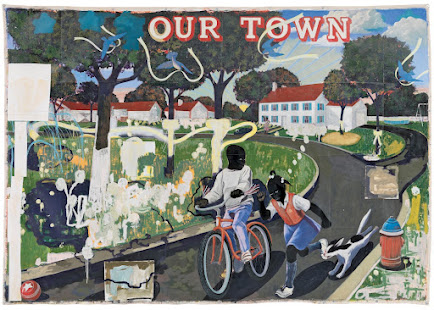Renaissance Blog
The Renaissance was known as the period of cultural, artistic, political, and economic “rebirth” after the Middle Ages. It was also a time in Europe that marks the transition between the Middle Ages to the modern era, which took place starting in Florence, Italy, and lasted from the 14th century to the 17th century. This period promoted the rediscovery of classic philosophy, art, and literature. Some of the most famous artists from this period are Jan van Eyck, Sandro Botticelli, Hieronymus Bosch, and Leonardo da Vinci. The artwork that I chose to look at is known as The Triumph of the Virtues.
The Triumph of the Virtues was created in 1502 by Italian Renaissance painter Andrea Mantegna. The painting is currently housed in Musée du Louvre, a house located in Paris. The painting portrays a marsh that is enclosed by a fence, ruled over by the Vices, which are disfigured hideously. In the painting, you can also see that Idleness is being chased by Minerva, the Roman goddess of wisdom, who is rescuing Diana, the Roman goddess of chastity, from being assaulted by a Centaur.
This painting is heavily influenced by humanism. Humanism was an intellectual movement marked by renewed interest in the classical world and studies that focused primarily on the essence of human beings. In The Triumph of the Virtues, there is a tree with human virtues right next to Minerva with Justice, Temperance, and Fortitude above it. These are some of the moral values that are considered to be core and primary in the life of any human being. This painting is done tactically, making sure that emotions are drawn out as how it was intended.
I would definitely like to own a copy of this masterpiece. The aesthetics in the painting are pleasing to look at. It is not only beautiful and well-crafted, but it looks so realistic. I really enjoy the artwork that looks realistic. Overall, The Triumph of the Virtues is an excellent illustration of an Italian Renaissance painting. The arrangement and the usage of colors in the painting all work together to create a potent image that is guaranteed to evoke emotion and wonder in the people who look at the painting. The artwork also gives away a deeper meaning and reminds us of the accomplishments during the Italian Renaissance.
Citations:
“Triumph of the Virtues.” Triumph of the Virtues by Andrea Mantegna. Accessed February 20, 2023. https://www.thehistoryofart.org/andrea-mantegna/triumph-of-the-virtues/.
“Art in Tuscany: Andrea Mantegna: Triumph of the Virtue, about 1502: Podere Santa Pia, Casa Vacanze in Maremma, Toscana.” Art in Tuscany | Andrea Mantegna | Triumph of the Virtue, about 1502 | Podere Santa Pia, Casa Vacanze in Maremma, Toscana. Accessed February 20, 2023. http://www.travelingintuscany.com/art/andreamantegna/trionfodellavirtu.htm.


_Preaching_to_the_Assembly_on_Vulture_Peak_LACMA_AC1998.268.1_(1_of_11).jpg)

Thank you for sharing, I really enjoyed reading your blog about "The Triumph of the Virtues". After looking through other people's blogs and what they chose, I noticed all the 15th century Italian Renaissance portraits are about fearing of the gods and chaos. I think that this mural depicts this perfectly. The painting that I chose was an architectural design called the "Fall of the Giants", like this painting it shows an apocalyptic scene where the gods are attacking one another/general chaos. What I took away was that this translates to the Reformation and dividing of the Catholic Church because at this time people believed the church was corrupt, so artists would express that through paintings like "The Triumph of the Virtues" and "Fall of the Giants" that expressed disruption in the sky.
ReplyDeleteThank you for sharing, I really enjoyed reading your blog about "The Triumph of the Virtues". After looking through other people's blogs and what they chose, I noticed all the 15th century Italian Renaissance portraits are about fearing of the gods and chaos. I think that this mural depicts this perfectly. The painting that I chose was an architectural design called the "Fall of the Giants", like this painting it shows an apocalyptic scene where the gods are attacking one another/general chaos. What I took away was that this translates to the Reformation and dividing of the Catholic Church because at this time people believed the church was corrupt, so artists would express that through paintings like "The Triumph of the Virtues" and "Fall of the Giants" that expressed disruption in the sky. (I don't know if the first one published...)
ReplyDeleteHi Gavin, thank you for sharing this piece with us! I have done some research on "Triumph of the Virtues" in past art history courses, and I have always enjoyed exploring this piece. The color scheme is my favorite, I really enjoy the way Mantegna uses such bright colors in the background with a soft break of dark colors to really showcase the brightness of the characters in the foreground. I agree with your thoughts on it representing Humanistic themes. The piece explores the idea of rising above proclivities and that is a theme that all humans go through.
ReplyDeleteI would love to have this piece hanging in my home!
Hi Gavin, thank you for sharing this art piece with us! I have had the chance to explore this piece in past art history courses and I truly enjoy it! I especially enjoy Mantegna's use of color. The Brightness of the background and then the break of dark colors to really bring attention to the foreground is quite amazing. I think it really helps to bring focus on the themes of rising above proclivities which ties into your discussion on its relationship to Humanism. I agree with your perspective, and I also agree on this piece provoking emotions and discussion.
ReplyDeleteI would love to have this work of art hanging in my home!
Hi Gavin, this painting is very interesting. There is so much going on and many different details that tell their own stories. There is so much to pick apart and find meaning in that. I love a painting that can tell more than one story. Humanism is definitely present in this painting in many different spots. You had a great example in your analysis and I can definitely see what you mean. Humanism was a huge part of the renaissance and it is something that was gatekept by certain intellectuals up until that point. Keep up the great work.
ReplyDeleteHi Gavin, great work on the post. This painting is really interesting and has so much going on. It has so many different details and stories that are being told. I love when a painting has more than one story going on as you are able to pick out certain parts and find out what they mean to you. You made a really great analyzation of humanism and found a great example of it in the painting. Humanism was something that was not popularized until the renaissance and was gatekept by certain intellectuals up until that period. Keep up the great work.
ReplyDelete